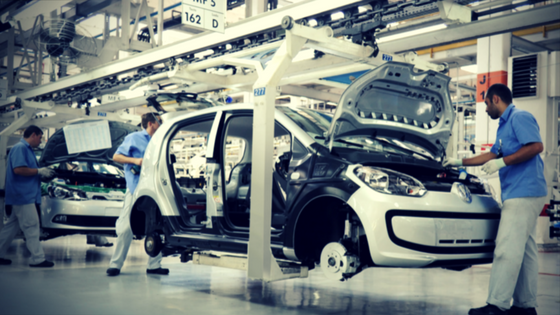From making individual parts to building the whole car, there’s a lot riding on your reputation in the automotive industry. While many non-automotive companies primarily concern themselves with the safety of their employees, your EHS department pulls double duty by also considering the safety of your end users.
Quality assurance in the auto industry has never been more paramount. In fact, your employees’ and consumers’ lives depend on it, not to mention your company’s reputation.
How to Shift Your Reputation into High Gear
Like other manufacturing companies, automotive producers are turning to web-based EHS software solutions to maintain high quality standards, streamline their health and safety data, and ultimately gain an edge over their competitors.
Quality Standards
Using enterprise EHS software as a daily operations tool can help managers understand and abide by strict quality standards, such as ISO 9001, to ensure that no substandard product leaves the production line. In addition, companies can monitor compliance and quality activities throughout their various locations and activities.
Risk Mitigation
It can be seemingly impossible to recover from the damages dealt by massive auto recalls. Automotive companies are recognizing the risk-reducing features of EHS management software as a best practice, namely how it boosts consistency across global and regional markets.
Public Trust
Part of a solid EHS program is letting consumers who rely on your products know what you are doing to keep them safe. Simply saying you prioritize their safety is easy, but proving it can be challenging if you don’t have a way to communicate it. Implementing EHS solutions, including sustainability software, into your operations can deliver a level of transparency to all stakeholders. It allows you to showcase your division's safety metrics on how exactly you are meeting requirements and considering the safety of everyone involved. These metrics are also an important component of your company's annual sustainability report.
Tips for Manufacturing Workers
All jobs are risky, but some jobs are riskier than others. This is definitely true of the automotive industry.
And that’s why safety in the automotive industry should be a leading concern for employers and employees alike. If you need somewhere to start, here are three essential tips to keep everyone safe at work.
Wear Protective Equipment
Let’s start with the basics: personal protective equipment (PPE).
If you’re working with machinery all day, there’s a lot of ways that things could go wrong. Something could fly into your eye. Toxic materials could splash on your hands. A part could fall and hit your foot.
And while you can’t plan for random workplace accidents, you can take steps to protect yourself from them. For example, wear protective glasses. Wear a hard hat. Wear steel-toed boots. Wear strong protective gloves. Even ear protection, whether it’s industrial earplugs or earmuffs, can protect your ears against noise damage and hearing loss.
Be Aware of Electrical and Fire Hazards
Since you work in the auto industry, there are some hazards that are more likely than others.
For example, electrical and fire hazards. Let’s say you’re a technician. And let’s say you’re working on a circuit. The circuit is misbehaving, or there’s water in the system, or you happen to have incredibly bad luck.
This could result in anything from a minor shock and embarrassment to serious electrical burns or electrocution. Unless, of course, you’re taking the appropriate steps to prevent electrical hazards.
For example, always make sure to use insulating materials and wear insulated protective gear, including gloves and glasses. Try to avoid coming into contact with electrical currents at all costs, but if you do so accidentally, insulated gear will help protect you.
Fire hazards and electrical hazards often go hand-in-hand, so you should always be aware of potential fire hazards. For instance, are you working with flammable materials? Are they stored safely? Do you have fire safety equipment nearby in case a fire did break out?
If you’re working with wires, always be aware of the state of the wires. If they’re frayed, don’t try to use them. And don’t try to turn on electrical current unless you’ve triple-checked the system.
Practice Good Housekeeping
It might sound basic, but good housekeeping goes a long way in keeping you safe.
Think about the amount of oil you encounter on a daily basis in the auto industry. Now think about the mess that follows oil. Oily rags, for example; you might be tempted to stuff one in your pocket for later use. Fluid could seep through your clothes and harm your skin. Also, keep in mind that oil is flammable, so if you plan on working with electrical currents, you shouldn’t have oil anywhere in the vicinity.
If you notice any spills, clean them up right away. This will prevent slip and fall accidents, protect the integrity of auto parts, and help protect the health of those who might be exposed to the substance.
Always be sure to keep sawdust on hand to wipe up oil spills. Once the sawdust has soaked up the oil, sweep it up. There’s no good reason to leave debris on the floor.
Guiding Safety in the Automotive Industry
With the volatile past decade of automotive disasters (like Toyota’s 4 million-plus vehicle recall in 2009-2010), companies are placing more emphasis on risk mitigation and compliance throughout the supply chain, along with increased quality demands. And finding easier ways to facilitate these actions, such as incorporating EHS software solutions, can make the difference between a well-oiled reputation or one that’s running on empty.
We know that safety in the automotive industry is one of the biggest issues that workers and managers face. That’s why we’re here to help you drive change.
We’re proud to provide novel solutions to your most complex problems. Where you’re trying to manage compliance tasks or you’re controlling quality, we can help. To learn more about how you can effectively manage your automotive EHS program, visit Automotive EHS Software.
